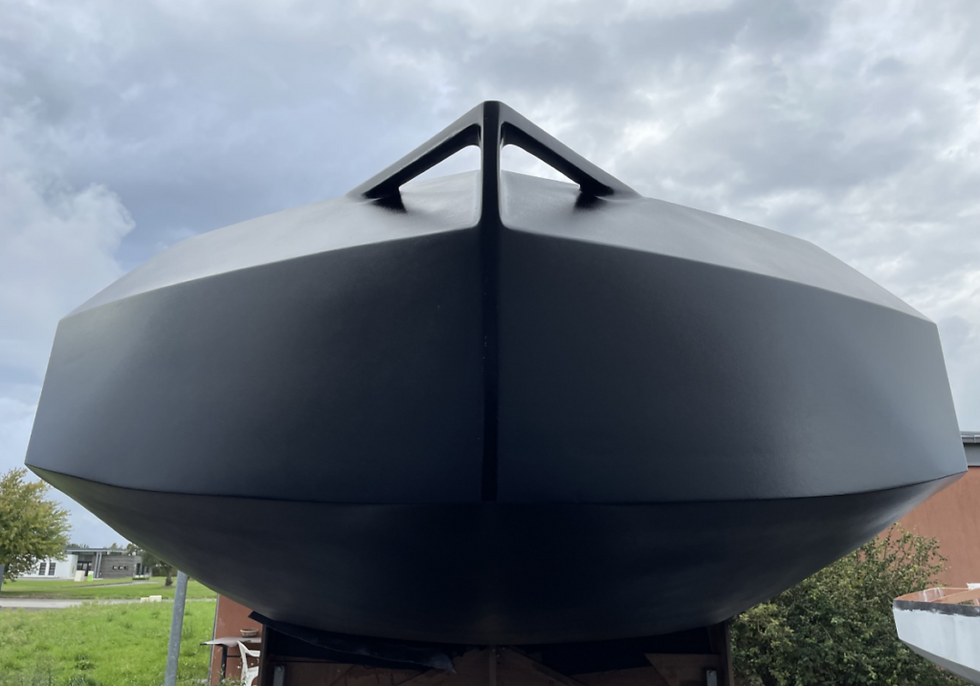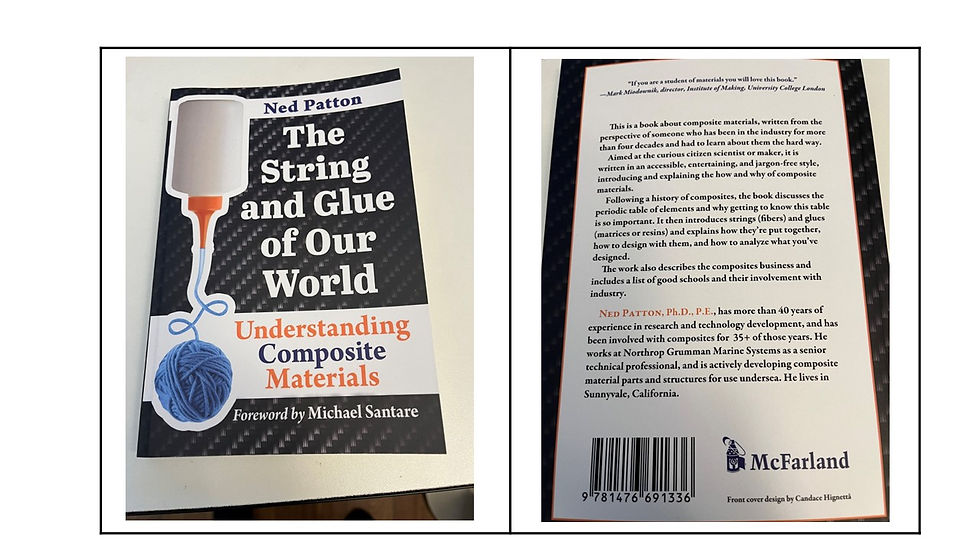Collection of Composites Sustainability Tidbits from Last Two Weeks
- Ned Patton

- Nov 5
- 6 min read
Since this is supposed to be a “newsletter” I thought I would collect some tidbits of news on the composites sustainability front that have come across my feed in the last couple of weeks. I did want to get a couple of state of the art posts done, so the last two weeks I haven’t been keeping everyone up with the latest news. And there has been some news to keep up with, especially in the recycling and reuse business and some developments in the circular economy approaches that are prevalent in Europe.

I thought I would start off with another of the things that is near and dear to my heart – a sailboat. This pic from JEC Composites shows a concept of a racing sailboat made using flax and basalt fiber, birch plywood, and a bio-based resin system from Sicomin specifically designed to work with wood. This resin system is specifically formulated to be free of all carcinogenic, mutagenic, or reprotoxic substances while maintaining extremely good adhesion to all fibers, including wood. It is also formulated for a wet layup process where the main part of the structure of the hull is birch plywood which is covered by flax fabric and a little basalt fiber in certain high stress spots to reinforce the flax. Since it’s a racing sailboat hull, they needed to get as much performance from every pound of hull as they could. And it appears that this thing is pretty competitive.

The Kaori shipyard in France put together this prototype, which is going to be on display at Metstrade, the big leisure marine show in Amsterdam later this month. This collaboration between Sicomin and the naval architect Gildas Plessis demonstrated approximately an 80% reduction in carbon footprint over the use of carbon fiber composites for this hull.

Apparently they did not suffer too much of a weight gain by going with this manner of construction. My guess is that they used the heavier materials toward the bottom of the hull which will allow them to use a bit less ballast to keep the boat upright in a strong wind. So this has a chance to be a stable and fast racing sailboat.

In Germany, the Germain Institutes of Textile and Fiber Research Denkendorf (DITF), which I have written about in the past, has collaborated with an outdoor sports equipment manufacturer, Leki Lenhart GmbH, to develop largely natural fiber hiking and cross country ski poles. Rather than using aluminum or carbon fiber, these are made largely from locally harvested flax fiber and a bio-based matrix material or bio-resin. The main part of the pole (the long black pole in the pic above) is a pultruded flax fiber with this bio-resin matrix material.
What the folks at DITF did was to interweave the fibers into a fabric tube that was pulled through a pultrusion die to form the tube and introduce the resin to the woven sock-like fiber tube to make the pole. The resin that they used was even a bit more bio-based than the Sicomin resin used for the Greenscow. Their resin system was 42% bio-based versus the 30% bio-based Sicomin resin. Nonetheless, this is a demonstration of a largely bio-based material system for use in the recreational sports equipment industry and looks to be a good start.

Two weeks ago I wrote a bit about how the Norwegian company Gjenkraft was recycling the fiberglass from wind turbine blades using a process much akin to what the Swiss company Composite Recycling uses – a thermolysis process that de-crosslinks the resin in fiberglass composites and separates glass from resin such that they can both be reused. I also mentioned that Gjenkraft had obtained funding to build and begin operations of a commercial thermolysis plant in Norway.
As recently as a couple of weeks ago, Composites World write an article about Gjenkraft signing a letter of intent with Owens Corning to provide their recycled glass fiber, once their commercial facility is up and running, to Owens Corning’s glass fiber manufacturing facilities. The idea is that the recycled glass fiber would be used as high quality raw stock for Owens Corning to manufacture in to new product forms ready to be made into new fiberglass parts.
This agreement is very similar to the consortium led by Beneteau with membership of Owens Corning, Composite Recycling, and several others to recycle end of life boat hulls into materials that can be pushed into the front end of the value chain for new glass fiber composites.

In the civil engineering world there is a company in Taiwan that has what they call a “microwave assisted” pyrolysis process that uses microwaves to heat the resin up in carbon fiber composite scrap and removes it very cleanly from the fiber. The recycled carbon fiber that results from this process is very clean, retaining nearly virgin carbon fiber properties. The market that they went after is the infrastructure market where they intend to replace steel reinforcing bar (rebar to those that are used to that term) with finely disbursed fairly short, recycled carbon fiber. This stuff apparently adheres to the mortar in concrete rathe well, and has demonstrated significantly higher strength in bending, tension, and compression tests. And this also makes the concrete lighter weight, and since the process for making this stuff relies on free carbon fiber scrap and just electricity, it is less expensive than traditional rebar.
In Taiwan, they are already using this new recycled carbon fiber reinforced concrete in tunnels and bridge decks, reinforcement of historic buildings and temple structures, and even as blast resistant concrete in military bunkers, chemical plants and some of their sensitive government facilities.

Finally, just last week the European Composites Industry Association (EuCIA) announced that the first General Assembly of the European Circular Composites Alliance will take place in December of this year. This alliance, announced in March of this year and officially kicked off in May, has grown to more than 160 organizations all across Europe. JEC Group which puts on JEC World, is a founding member of this organization, which is being managed by the EuCIA. JEC World is the largest composites conference and symposium in the world each year and is taking place in Paris March 10-12, 2026. This is going to provide another opportunity for the ECCA to meet in person and review progress in their first year.
This should be an interesting meeting and it demonstrates the European commitment to the development of a circular economy for composite materials and the entire composites industry. It is very apparent that the Europeans are leading the way in this regard and that the entire industry is involved. The fact that the EuCIA is managing this alliance, and that there are 160 organizations that have joined demonstrates the commitment that this sort of endeavor needs in order to be successful industrywide.
That’s about it for this week’s post. As always, I hope everyone that reads these posts enjoys them as much as I enjoy writing them. I will post this first on my website – www.nedpatton.com – and then on LinkedIn. And if anyone wants to provide comments to this, I welcome them with open arms. Comments, criticisms, etc. are all quite welcome. I really do want to engage in a conversation with all of you about composites because we can learn so much from each other as long as we share our own perspectives. And that is especially true of the companies and research institutions that I mention in these posts. The more we communicate the message the better we will be able to effect the changes in the industry that are needed.
My second book, which may be out in the late fall, is a roadmap to a circular and sustainable business model for the industry which I hope that at least at some level the industry will follow. Only time will tell. At least McFarland announced it in their Fall Catalog. And this time it is under a bit different category – Science and Technology. Maybe it will get noticed – as always that is just a crap shoot.
As I have said before, my publisher and my daughter have come to an agreement about the cover. So, I’ve included the approved cover at the end of this post. Let me know whether or not you like the cover. Hopefully people will like it enough and will be interested enough in composites sustainability that they will buy it. And of course I hope that they read it and get engaged. We need all the help we can get.
Last but not least, I still need to plug my first book. “The String and Glue of our World” pretty much covers the watershed in composites, starting with a brief history of composites, then introducing the Periodic Table and why Carbon is such an important and interesting element. The book was published and made available August of 2023 and is available both on Amazon and from McFarland Books – my publisher. However, the best place to get one is to go to my website and buy one. I will send you a signed copy for the same price you would get charged on Amazon for an unsigned one, except that I have to charge for shipping. Anyway, here’s the link to get your signed copy: https://www.nedpatton.com/product-page/the-string-and-glue-of-our-world-signed-copy. And as usual, here are pictures of the covers of both books.





Comments